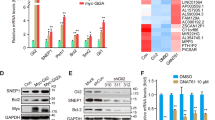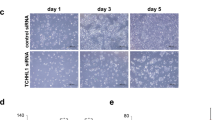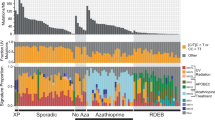Abstract
Deregulation of the hedgehog (HH) pathway results in overexpression of the GLI target BCL2 and is an initiating event in specific tumor types including basal cell carcinoma of the skin. Regulation of the HH pathway during keratinocyte differentiation is not well understood. We measured HH pathway activity in response to differentiation stimuli in keratinocytes. An upregulation of suppressor of fused (SUFU), a negative regulator of the HH pathway, lowered HH pathway activity and was accompanied by loss of BCL2 expression associated with keratinocyte differentiation. We used in vitro and in vivo models to demonstrate that ΔNp63α, a crucial regulator of epidermal development, activates SUFU transcription in keratinocytes. Increasing SUFU protein levels inhibited GLI-mediated gene activation in suprabasal keratinocytes and promoted differentiation. Loss of SUFU expression caused deregulation of keratinocyte differentiation and BCL2 overexpression. Using in vivo murine models, we also provide evidence of GLI-mediated regulation of the TP63 pathway. p63 expression appears essential to establish an optimally functioning HH pathway. These observations present a regulatory mechanism by which SUFU acts as an interacting node between the HH and TP63 pathways to mediate differentiation and maintain epidermal homeostasis. Disruption of this regulatory node can be an important contributor to multistep carcinogenesis.
Similar content being viewed by others
Log in or create a free account to read this content
Gain free access to this article, as well as selected content from this journal and more on nature.com
or
Abbreviations
- HH:
-
hedgehog
- BCC:
-
basal cell carcinoma
- SUFU:
-
suppressor of fused
- SHH:
-
sonic hedgehog
- SMO:
-
smoothened
- PTCH:
-
patched
- TA:
-
transactivation domain
- ΔN:
-
amino-terminal truncated protein
- p63α:
-
α-isoforms of ΔNp63 and TAp63
- PHK:
-
primary human keratinocyte
- IHC:
-
immunohistochemistry
- WT:
-
wild type
- MEF:
-
mouse embryonic fibroblast
- ΔNp63α BG:
-
ΔNp63α bigenic mice
- TG:
-
transgenic
References
Fuchs E, Byrne C . The epidermis: rising to the surface. Curr Opin Genet Dev 1994; 4: 725–736.
Nagarajan P, Romano RA, Sinha S . Transcriptional control of the differentiation program of interfollicular epidermal keratinocytes. Crit Rev Eukaryot Gene Expr 2008; 18: 57–79.
Epstein EH . Basal cell carcinomas: attack of the hedgehog. Nat Rev Cancer 2008; 8: 743–754.
Mills AA, Zheng B, Wang XJ, Vogel H, Roop DR, Bradley A . p63 is a p53 homologue required for limb and epidermal morphogenesis. Nature 1999; 398: 708–713.
Yang A, Schweitzer R, Sun D, Kaghad M, Walker N, Bronson RT et al. p63 is essential for regenerative proliferation in limb, craniofacial and epithelial development. Nature 1999; 398: 714–718.
Su X, Paris M, Gi YJ, Tsai KY, Cho MS, Lin YL et al. TAp63 prevents premature aging by promoting adult stem cell maintenance. Cell Stem Cell 2009; 5: 64–75.
Koster MI, Kim S, Mills AA, DeMayo FJ, Roop DR . p63 is the molecular switch for initiation of an epithelial stratification program. Genes Dev 2004; 18: 126–131.
Romano RA, Smalley K, Magraw C, Serna VA, Kurita T, Raghavan S et al. DeltaNp63 knockout mice reveal its indispensable role as a master regulator of epithelial development and differentiation. Development 2012; 139: 772–782.
Nguyen BC, Lefort K, Mandinova A, Antonini D, Devgan V, Della Gatta G et al. Cross-regulation between Notch and p63 in keratinocyte commitment to differentiation. Genes Dev 2006; 20: 1028–1042.
Yang A, Kaghad M, Wang Y, Gillett E, Fleming MD, Dotsch V et al. p63, a p53 homolog at 3q27-29, encodes multiple products with transactivating, death-inducing, and dominant-negative activities. Mol Cell 1998; 2: 305–316.
Koster MI, Dai D, Marinari B, Sano Y, Costanzo A, Karin M et al. p63 induces key target genes required for epidermal morphogenesis. Proc Natl Acad Sci USA 2007; 104: 3255–3260.
Truong AB, Kretz M, Ridky TW, Kimmel R, Khavari PA . p63 regulates proliferation and differentiation of developmentally mature keratinocytes. Genes Dev 2006; 20: 3185–3197.
Ingham PW, Nakano Y, Seger C . Mechanisms and functions of Hedgehog signalling across the metazoa. Nat Rev Genet 2011; 12: 393–406.
Kogerman P, Grimm T, Kogerman L, Krause D, Unden AB, Sandstedt B et al. Mammalian suppressor-of-fused modulates nuclear-cytoplasmic shuttling of Gli-1. Nat Cell Biol 1999; 1: 312–319.
Ding Q, Fukami S, Meng X, Nishizaki Y, Zhang X, Sasaki H et al. Mouse suppressor of fused is a negative regulator of sonic hedgehog signaling and alters the subcellular distribution of Gli1. Curr Biol 1999; 9: 1119–1122.
Ghali L, Wong ST, Green J, Tidman N, Quinn AG . Gli1 protein is expressed in basal cell carcinomas, outer root sheath keratinocytes and a subpopulation of mesenchymal cells in normal human skin. J Invest Dermatol 1999; 113: 595–599.
Ruiz i Altaba A, Sanchez P, Dahmane N . Gli and hedgehog in cancer: tumours, embryos and stem cells. Nat Rev Cancer 2002; 2: 361–372.
Taylor MD, Liu L, Raffel C, Hui CC, Mainprize TG, Zhang X et al. Mutations in SUFU predispose to medulloblastoma. Nat Genet 2002; 31: 306–310.
Bigelow RL, Chari NS, Unden AB, Spurgers KB, Lee S, Roop DR et al. Transcriptional regulation of bcl-2 mediated by the sonic hedgehog signaling pathway through gli-1. J Biol Chem 2004; 279: 1197–1205.
Regl G, Kasper M, Schnidar H, Eichberger T, Neill GW, Philpott MP et al. Activation of the BCL2 promoter in response to Hedgehog/GLI signal transduction is predominantly mediated by GLI2. Cancer Res 2004; 64: 7724–7731.
Cory S, Huang DC, Adams JM . The Bcl-2 family: roles in cell survival and oncogenesis. Oncogene 2003; 22: 8590–8607.
Spurgers KB, Chari NS, Bohnenstiehl NL, McDonnell TJ . Molecular mediators of cell death in multistep carcinogenesis: a path to targeted therapy. Cell Death Differ 2006; 13: 1360–1370.
Polakowska RR, Piacentini M, Bartlett R, Goldsmith LA, Haake AR . Apoptosis in human skin development: morphogenesis, periderm, and stem cells. Dev Dyn 1994; 199: 176–188.
Alfandari J, Shnitman Magal S, Jackman A, Schlegel R, Gonen P, Sherman L . HPV16 E6 oncoprotein inhibits apoptosis induced during serum-calcium differentiation of foreskin human keratinocytes. Virology 1999; 257: 383–396.
Carlsson H, Yhr M, Petersson S, Collins N, Polyak K, Enerback C . Psoriasin (S100A7) and calgranulin-B (S100A9) induction is dependent on reactive oxygen species and is downregulated by Bcl-2 and antioxidants. Cancer Biol Ther 2005; 4: 998–1005.
Flores ER, Lambert PF . Evidence for a switch in the mode of human papillomavirus type 16 DNA replication during the viral life cycle. J Virol 1997; 71: 7167–7179.
Boukamp P, Petrussevska RT, Breitkreutz D, Hornung J, Markham A, Fusenig NE . Normal keratinization in a spontaneously immortalized aneuploid human keratinocyte cell line. J Cell Biol 1988; 106: 761–771.
Katagata Y, Aoki T, Kondo S . Detecting expression of keratins 8/18 in human HaCaT keratinocytes. J Dermatol Sci 1999; 19: 139–143.
Vigano MA, Lamartine J, Testoni B, Merico D, Alotto D, Castagnoli C et al. New p63 targets in keratinocytes identified by a genome-wide approach. Embo J 2006; 25: 5105–5116.
Yang A, Zhu Z, Kapranov P, McKeon F, Church GM, Gingeras TR et al. Relationships between p63 binding, DNA sequence, transcription activity, and biological function in human cells. Mol Cell 2006; 24: 593–602.
Romano RA, Smalley K, Liu S, Sinha S . Abnormal hair follicle development and altered cell fate of follicular keratinocytes in transgenic mice expressing DeltaNp63alpha. Development 2010; 137: 1431–1439.
Berman DM, Desai N, Wang X, Karhadkar SS, Reynon M, Abate-Shen C et al. Roles for Hedgehog signaling in androgen production and prostate ductal morphogenesis. Dev Biol 2004; 267: 387–398.
Chiang C, Swan RZ, Grachtchouk M, Bolinger M, Litingtung Y, Robertson EK et al. Essential role for Sonic hedgehog during hair follicle morphogenesis. Dev Biol 1999; 205: 1–9.
St-Jacques B, Dassule HR, Karavanova I, Botchkarev VA, Li J, Danielian PS et al. Sonic hedgehog signaling is essential for hair development. Curr Biol 1998; 8: 1058–1068.
Signoretti S, Waltregny D, Dilks J, Isaac B, Lin D, Garraway L et al. p63 is a prostate basal cell marker and is required for prostate development. Am J Pathol 2000; 157: 1769–1775.
Kasper M, Jaks V, Are A, Bergstrom A, Schwager A, Svard J et al. Wounding enhances epidermal tumorigenesis by recruiting hair follicle keratinocytes. Proc Natl Acad Sci USA 2011; 108: 4099–4104.
Caserta TM, Kommagani R, Yuan Z, Robbins DJ, Mercer CA, Kadakia MP . p63 overexpression induces the expression of Sonic Hedgehog. Mol Cancer Res 2006; 4: 759–768.
Frank-Kamenetsky M, Zhang XM, Bottega S, Guicherit O, Wichterle H, Dudek H et al. Small-molecule modulators of Hedgehog signaling: identification and characterization of Smoothened agonists and antagonists. J Biol 2002; 1: 10.
Rinne T, Brunner HG, van Bokhoven H . p63-associated disorders. Cell Cycle 2007; 6: 262–268.
Mikkola ML . p63 in skin appendage development. Cell Cycle 2007; 6: 285–290.
Hui CC, Angers S . Gli proteins in development and disease. Annu Rev Cell Dev Biol 2011; 27: 513–537.
Visinoni AF, Lisboa-Costa T, Pagnan NA, Chautard-Freire-Maia EA . Ectodermal dysplasias: clinical and molecular review. Am J Med Genet A 2009; 149A: 1980–2002.
Lippens S, Denecker G, Ovaere P, Vandenabeele P, Declercq W . Death penalty for keratinocytes: apoptosis versus cornification. Cell Death Differ 2005; 12 (Suppl 2): 1497–1508.
Rodriguez-Villanueva J, Greenhalgh D, Wang XJ, Bundman D, Cho S, Delehedde M et al. Human keratin-1.bcl-2 transgenic mice aberrantly express keratin 6, exhibit reduced sensitivity to keratinocyte cell death induction, and are susceptible to skin tumor formation. Oncogene 1998; 16: 853–863.
Svard J, Heby-Henricson K, Persson-Lek M, Rozell B, Lauth M, Bergstrom A et al. Genetic elimination of Suppressor of fused reveals an essential repressor function in the mammalian Hedgehog signaling pathway. Dev Cell 2006; 10: 187–197.
Taylor MD, Zhang X, Liu L, Hui CC, Mainprize TG, Scherer SW et al. Failure of a medulloblastoma-derived mutant of SUFU to suppress WNT signaling. Oncogene 2004; 23: 4577–4583.
Nakayama K, Negishi I, Kuida K, Sawa H, Loh DY . Targeted disruption of Bcl-2 alpha beta in mice: occurrence of gray hair, polycystic kidney disease, and lymphocytopenia. Proc Natl Acad Sci USA 1994; 91: 3700–3704.
King KE, Weinberg WC . p63: defining roles in morphogenesis, homeostasis, and neoplasia of the epidermis. Mol Carcinog 2007; 46: 716–724.
Brandner S . Nanog, Gli, and p53: a new network of stemness in development and cancer. Embo J 2010; 29: 2475–2476.
Ho L, Alman B . Protecting the hedgerow: p53 and hedgehog pathway interactions. Cell Cycle 2010; 9: 506–511.
Wang GY, Wang J, Mancianti ML, Epstein EH Jr . Basal cell carcinomas arise from hair follicle stem cells in Ptch1(+/−) mice. Cancer Cell 2011; 19: 114–124.
McKeon F . p63 and the epithelial stem cell: more than status quo? Genes Dev 2004; 18: 465–469.
King KE, Ponnamperuma RM, Gerdes MJ, Tokino T, Yamashita T, Baker CC et al. Unique domain functions of p63 isotypes that differentially regulate distinct aspects of epidermal homeostasis. Carcinogenesis 2006; 27: 53–63.
Suzuki D, Senoo M . Increased p63 phosphorylation marks early transition of epidermal stem cells to progenitors. J Invest Dermatol 2012; 132: 2461–2464.
Candi E, Rufini A, Terrinoni A, Dinsdale D, Ranalli M, Paradisi A et al. Differential roles of p63 isoforms in epidermal development: selective genetic complementation in p63 null mice. Cell Death Differ 2006; 13: 1037–1047.
Melino G . p63 is a suppressor of tumorigenesis and metastasis interacting with mutant p53. Cell Death Differ 2011; 18: 1487–1499.
Humke EW, Dorn KV, Milenkovic L, Scott MP, Rohatgi R . The output of Hedgehog signaling is controlled by the dynamic association between Suppressor of Fused and the Gli proteins. Genes Dev 2010; 24: 670–682.
Kasper M, Regl G, Eichberger T, Frischauf AM, Aberger F . Efficient manipulation of Hedgehog/GLI signaling using retroviral expression systems. Methods Mol Biol 2007; 397: 67–78.
Sasaki H, Hui C, Nakafuku M, Kondoh H . A binding site for Gli proteins is essential for HNF-3beta floor plate enhancer activity in transgenics and can respond to Shh in vitro. Development 1997; 124: 1313–1322.
Assikis VJ, Do KA, Wen S, Wang X, Cho-Vega JH, Brisbay S et al. Clinical and biomarker correlates of androgen-independent, locally aggressive prostate cancer with limited metastatic potential. Clin Cancer Res 2004; 10: 6770–6778.
Diamond I, Owolabi T, Marco M, Lam C, Glick A . Conditional gene expression in the epidermis of transgenic mice using the tetracycline-regulated transactivators tTA and rTA linked to the keratin 5 promoter. J Invest Dermatol 2000; 115: 788–794.
Acknowledgements
This work was partially supported by NCI grant U01 CA105345. We acknowledge grant support from the Swedish Research Council (to ST) and Swedish Cancer Society (to RT), Estonia Research Council (grant no. 8932), and EMBO Installation grant (to VJ, Austrian Science Fund (project no. P20652) and Austrian Genome Project-Gen AU (to FA)). Also we acknowledge Ahn Hoang and J Havilland for help with IHC, and Henry Adams for advice and guidance in microscopy image acquisition.
Author information
Authors and Affiliations
Corresponding author
Ethics declarations
Competing interests
The authors declare no conflict of interest.
Additional information
Edited by G Melino
Supplementary Information accompanies this paper on Cell Death and Differentiation website
Rights and permissions
About this article
Cite this article
Chari, N., Romano, R., Koster, M. et al. Interaction between the TP63 and SHH pathways is an important determinant of epidermal homeostasis. Cell Death Differ 20, 1080–1088 (2013). https://doi.org/10.1038/cdd.2013.41
Received:
Revised:
Accepted:
Published:
Issue date:
DOI: https://doi.org/10.1038/cdd.2013.41
Keywords
This article is cited by
-
p63: a crucial player in epithelial stemness regulation
Oncogene (2023)
-
How Does p73 Cause Neuronal Defects?
Molecular Neurobiology (2016)



